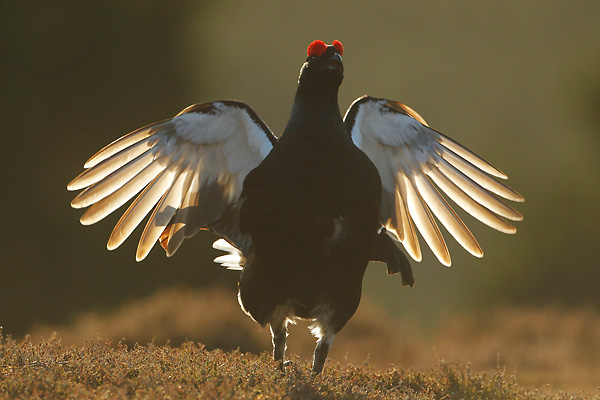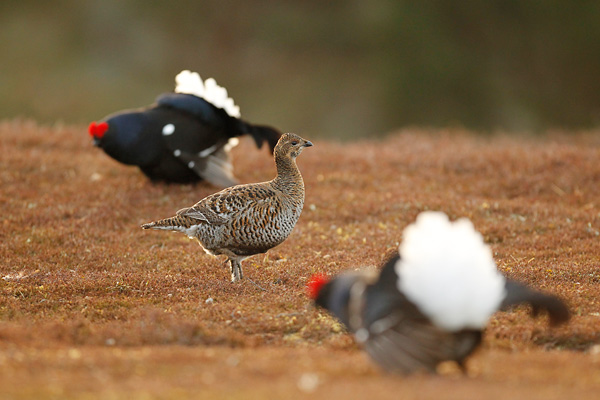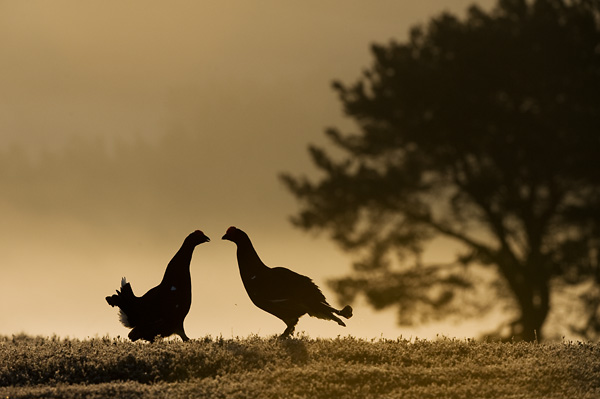Black grouse or blackcock is a species with which I have a love-hate relationship. For the most part I love them. The hate bit comes in when the alarm goes off in the middle of the night and the last thing I want to do is get out of bed and drive for an hour and then stomp across a wet moorland in the dark to sit in a cold hide. It just isn’t very appealing and no one with any sense would do such a thing but then these people perhaps don’t know what they’re missing. To witness blackcock strutting their stuff on their display grounds (lek) at dawn is undoubtedly one of the greatest birding spectacles Britain has to offer. It is raw and often very aggressive animal emotion as males defend their turf near the centre of the lek where watching females eye up their suitors and eventually offer themselves for mating. Only the fittest, strongest males win this ‘right’ to mate whilst less able birds and younger males can only watch on the sidelines. It is really is dog eat dog out there.

I have photographed blackcock many times over the past few years and you would have thought that I would have got what I wanted by now. After all how hard can it be? Well it is actually quite hard – not necessarily to get good shots but to get something a bit different – and the opportunity for actually taking pictures is short because of the low light conditions when they are displaying most vigourously. The birds arrive on the lek about 1 hour before sunrise at which time it’s just their white tail feathers that are visible in the gloom. I usually start to mess round with some very slow shutter speed work (1 – 2 secs) fairly early on using high ISO settings but generally the results are all throw-aways but now and then something ‘arty’ pops up but it does take a bit of imagination to work out what’s going on in the picture! The advent of low noise, high ISO shooting is a real godsend though for blackcock photography and useable images can now be obtained at ISO3200.

The position of the lek I have been working is such that its possible to shoot from almost any position -n front lit, back lit, lying down etc. so there are really limitless possibilities. After a couple of ‘regular’ sessions, which didn’t really yield anything I hadn’t got before, I tried using my low level hide to get a different perspective. This produced some good results but I had to be content with photographing just two of the birds as the others were in a bit of a dip and out of view. The following week the weather was settled with clear cool nights and so I wanted to try to get some back lit images that would hopefully show up the bird’s breath when they called. By shooting into a dark hillside opposite this worked pretty well and I was pleased with the results. I tried again the following morning but this time it was hazy and warmer and there was no breath visible. It’s always a bit of a risk photographing this way because if the intended shot doesn’t come off then the light is very quickly too harsh to shoot ‘regular’ material and you come away with nothing.

A day or two passed before I went back again, once more setting up for backlit images. It was a cold morning with a slight frost – ideal conditions – and soon a mist was moving up the valley adding further to the dramatic conditions. I knew that once the sun rose, this mist would begin to glow orange and would provide a fantastic backdrop for the grouse. The only concern was having two males squaring up to each in the right place at the right time in what would only be a 5-10 minute window. Individual blackcock always take up the same position on the lek and fight in exactly the same spot every morning so I knew that two of the males would fight in a good position although they didn’t do it very often. Sure enough as the sun came up over the far hill the lek was bathed in glorious light coming through a veil of mist. A few minutes passed and the males remained in their respective positions but not where I wanted them. Then all of a sudden their activity cranked up 10 fold as a female flew overhead calling as she went and landed just outside the leking arena. The presence of a female always sparks a frenzy of activity as males vie for attention – leaping high into the air performing elaborate ‘flutter jumps’.
A female is always worth fighting over too and, just in time from my point of view with the light still optimum, two males moved into the ideal position and engaged in a few seconds of fighting activity. It was all over very quickly but it was long enough for me to capture the shot I wanted. But have I ‘done’ blackcock? – have I heck and I’ll be back again next spring – I can’t wait!



Great story and images. Personally I love the first and the last image. Great light and mood. Gr. Kristel
Thanks, Kristel
I look at your images of Black Grouse once and once again. They are incomparable to any Black Grouse photos made by Lithuanian photographers. The main difference is how you use the light. I looked at these images and thought to try something similar (to photograph a Corncrake against the sun). Here the Corncrake isn’t a rare bird, but I’ve already taken a photo of this bird and I think that the second attempt should be enough if I care about the bird. The Corncrake didn’t come exactly where I wanted, but I still realized that it’s not easy to get good photos of this bird against the sun. Maybe this technique works better with some species while not that good with others? Or are there any secrets? 🙂
Thanks for your wonderful photographs, Mark!
I think that it is easier to use this technique with some species more than others. The is no secret really but it’s good to have a situation where you are able to get a clear view of the birds against a ‘solid’ darker background so that they stand out well. I think also that these images work much better if you shoot with low sunlight – either early or late in the day. And it helps if the sun is not too strong – diffused sun or when there is some mist around is ideal.
After looking through the miriads of Black Grouse lek images, I can safely say the last one you’ve created here is one of the most memorable.
It’s like an image from a memory, not rich in detail but an experience, one that doesn’t have a timestamp. I really like it.
Chris